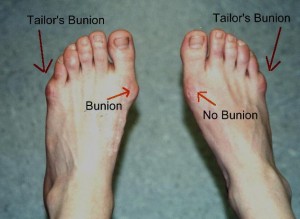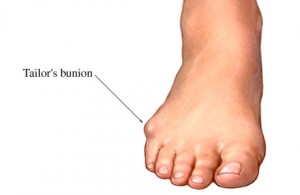Tailor’s Bunion Definition
Page Contents
Tailor’s Bunion, also known as Bunionette, is a painful condition of the foot similar to Bunion (painful swelling of the bursa in the big toe). This abnormality ensues from the occasional inflammation of the fifth metatarsal bone located near the base of the little toe.
The condition is known as “Tailor’s Bunion” due to the fact that tailors used to suffer from the disorder very frequently. They had to sit cross-legged and barefoot for long periods of time and the outside edge of the feet rubbed on the ground, applying extra pressure on the area. This resulted in Bunionette. The problem can also be referred to as Metatarsalgia and Intractable Plantar Keratosis.
Tailor’s Bunion Causes
An inherited fault in the mechanical structure of the foot can result in this kind of foot injury. The existing fault can result in changes in the bony framework of the foot which leads to an enlargement in certain areas. As a result, the metatarsal bone in the fifth toe begins to protrude outward and the toe starts to move inward. This change leads to the development of a bump on the side of the foot if the area is irritated due to wearing a tight shoe.
In some cases, Bunionette is actually a bone outgrowth or bony spur which develops on the fifth metatarsal bone. Wearing narrow shoes can put excessive pressure on the sides of the foot which ultimately causes this condition.
Bone destruction caused by some specific types of Arthritis, such as the Psoriatic and Rheumatoid Arthritis, can lead to misalignment of joints which results in the formation of a bunion. Sometimes, the normal functioning and pull of the foot muscles and tendons may be affected by some neuromuscular diseases, causing deformation and imbalance of the structure of the foot. Other causes of foot structure damage include:
- Muscle trauma
- Bone or muscle surgery
- Irregularity in the length of two legs
Certain activities, such as ballet dancing and running while wearing tight shoes can also increase the risk of developing the disorder.
Tailor’s Bunion Symptoms
This condition generally aggravates if an individual continues to wear tight shoes and put pressure on the affected area. The symptoms get worse with the advancement of the injury, leading to other serious bone and muscle disorders. Following are some of the principal symptoms of Bunionette:
- Development of a bump near the base of the little toe
- Numbness and a throbbing pain in and around the swollen area
- Possible increase of pain, at a gradual pace, over time
- Redness and irritation in the area of the foot where the skin rubs against the shoe
- Development of a callus in the affected skin area
- Swelling of the bursa located in the fifth toe, leading to a painful condition named Bursitis
- Severe rubbing and pressure can even result in an ulcer on the affected area
- Grinding sensation with movement in the base of the little toe
Tailor’s Bunion Diagnosis
It helps physicians to make a preliminary diagnosis due to the protrusion at the side of the little toe being evident. This is followed by studying the symptoms of patients to rule out the possibility of a fracture or some other bone injury. An x-ray can be done to find out the exact causes and extent of the abnormality. X-ray can also help the doctor to decide whether the deformity requires surgery. Sometimes, a physician may also order an MRI scan for confirming the diagnosis.
Tailor’s Bunion Treatment
Most cases of the condition can be treated with appropriate medication, physical therapy and exercise. It is also important to take some measures for avoiding any further injury to the affected area.
Non-surgical Treatment
Following are the various non-surgical treatment options used to cure this condition:
Shoe Modification
It is advisable to wear shoes with a broad toe box. One should also avoid wearing shoes with high heels and pointed toes.
Padding
Protecting the swollen area with Bunionette pads also helps to reduce the pain.
Oral Medications
NSAIDs (nonsteroidal anti-inflammatory drugs) like ibuprofen can help to relieve the inflammation and pain.
Ice Pack
Applying an ice pack on the affected area helps to reduce the pain. It is advisable to wrap the ice in a piece of cloth to avoid applying it directly to the skin.
Injection Therapy
Corticosteroid injections are sometimes used for treating the inflamed tissues around the injured joint.
Taping
The physician may tape the affected feet for pain-relief. Taping restricts the movement of the injured toe and protects it from further damage.
Orthotic Devices
Comparatively severe cases of the disorder are treated with custom orthotic devices. These devices include day and night splints, braces, toe spacers, toe straightener and gel Bunion guards.
Exercises
Knee and hip flexion along with extension exercises help to keep the pain in control. Wiggling the toes is a useful exercise that can help to prevent the occurrence of this condition. Performing some foot stretching exercises is beneficial for restoring the movement of the toes. These workouts also help the toes to regain their proper positions.
Tailor’s Bunion Surgery
Operation may be required in cases where all the above-mentioned treatment measures fail to reduce the pain and keep the swelling in control. Removal of the Bunionette is one of the most commonly used corrective surgeries. Majority of these surgeries are performed under an ankle block anesthesia. Various factors, like the extent of the deformity as well as the age and activity level of patients are considered by a surgeon while deciding the appropriate surgery for a patient.
Bunionette Removal
In this surgery, a small incision is made by the surgeon over the bump for repairing the abnormality. The surgeon then removes the protrusion with a chisel and smoothens the bone edges. The incision is closed with stitches after the operation is complete. The stitches are removed 10-14 days after the technique is performed.
Tailor’s Bunion Home Remedy
It is possible to keep the swelling and pain in control by following certain remedial guidelines at home:
- Wearing wide and flat shoes to avoid putting pressure on the fifth metatarsal bone.
- Wearing proper socks can keep the toes protected by providing a cushion effect
- Using pain-reliever sprays and gels
- Applying ice packs onto the affected area for 10 minutes everyday
- Using stretchable shoes to prevent the swelling from getting worse
Tailor’s Bunion Prognosis
The prognosis is generally positive with timely and proper treatment. A patient has to wear special post-operation shoes to keep the foot from any damage following the surgery. He or she may also require crutches for a short time after the operation. In some very rare instances, Bunionette can lead to blood clots in the foot which can turn life-threatening. In most cases, however, sufferers achieve full recovery. The recovery time required by the patients generally depends on the treatment option that is used.
Tailor’s Bunion Prevention
It is not possible to prevent the congenital foot defect which is the most common cause of this disorder. People with an abnormal foot structure should wear proper shoes and avoid high heels to prevent the development of Bunion. Wearing shoes with spacious toe boxes prevents putting extra pressure on the sides of the foot. Bunion guard, a padding or cushion over the bony areas at the toe base, can be used for protecting the foot.
Applying some ice and using some anti-inflammatory medications can help to prevent the development of Bunionette in cases where the skin becomes swollen and irritated due to pressure or some injury.
Tailor’s Bunion Pictures
The following pictures show how this disorder affects the external appearance of the foot.
Picture 1 – Tailor’s Bunion
Picture 2 – Tailor’s Bunion Image
Proper treatment is essential for curing the pain and correcting Tailor’s Bunion. If cured in the right manner, patients can go back to their normal activity level after treatment.
References:
http://www.foothealthfacts.org/footankleinfo/tailors-bunion.htm
http://orthopedics.about.com/od/toeproblems/a/bunionette.htm
http://www.orthogate.org/patient-education/foot/bunionette-tailors-bunion.html
https://nwfootankle.com/foot-health/drill/3-Problems/35-Tailor%27s%20Bunion
http://www.ctfootgroup.com/tailors-bunion-bunionette.html


